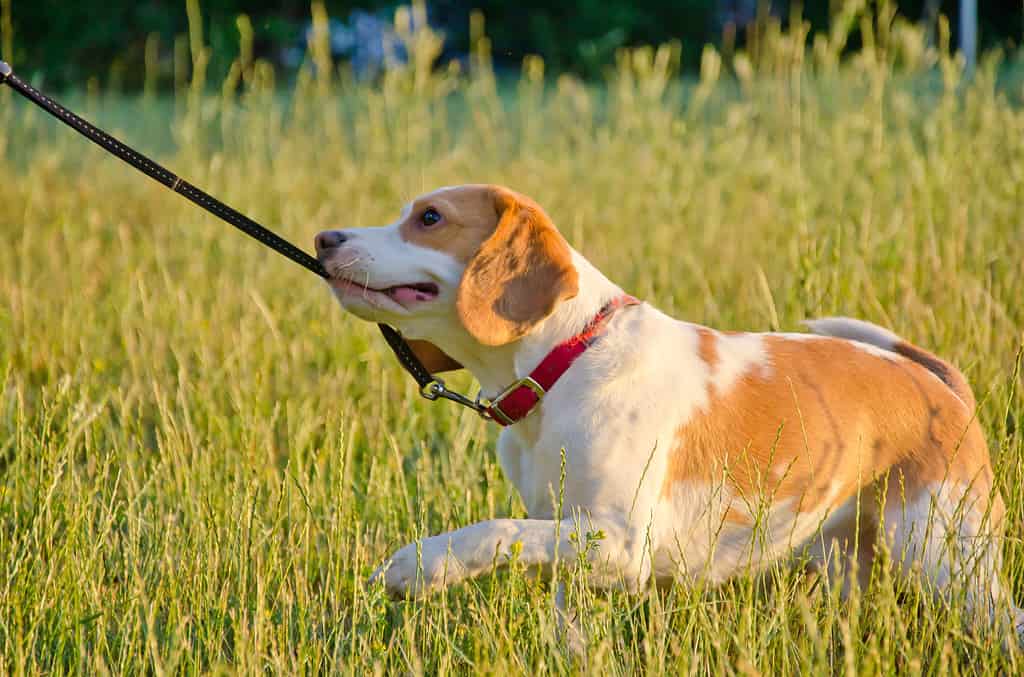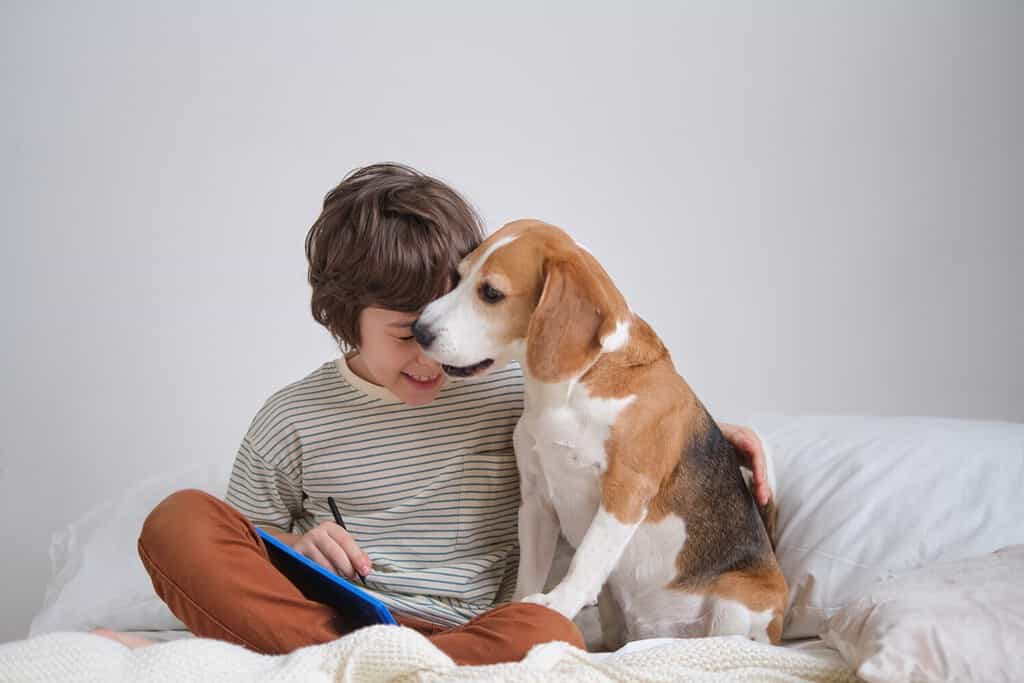Training your beagle doesn’t have to be a nightmare. Understanding your dog’s personality will help you meet your beagle’s physical and mental needs while developing the right training strategies. Are you ready to learn how to train your beagle? Below are the 10 best methods and tips for teaching you and your beagle the basics.
How to Train Your Beagle: Common Training Challenges

Beagles are used for hunting because they have a phenomenal sense of smell.
©Olena Kurashova/iStock via Getty Images
Beagles have a reputation as one of the most challenging dog breeds to train. After all, they are high-energy hunting dogs. But what makes training these scent hounds so tricky is their innate curiosity and independence.
Unlike other popular family dogs, such as golden and Labrador retrievers, beagles don’t need to please their owners. They are loving and tend to be docile but ultimately follow their instincts. They are bred to follow their noses to lead the pack to the rabbit.
Figuring out how to train your beagle can be challenging. You will need to tailor your training to your beagle’s temperament, personality, and history to devise a training plan that works for both of you.
Here are some common challenges many owners have when training their beagle:
- Dealing with high energy levels
- Working around a rebellious and independent attitude
- Distractions and prey drive
- Ending incessant barking
- Potty training
All of these challenges are addressed in this guide, along with ways to remedy them.
Despite the difficulty you may face during certain training phases, beagles are intelligent and loving dogs. You can successfully train your beagle at any age with the proper methods, structure, time, and patience.
How to Train Your Beagle: Training Timeline

Hyperactivity in beagles noticeably declines around two to two-and-a-half years old.
©NinaM/Shutterstock.com
Eight to 12 weeks is the best time to teach your puppy their name, simple commands like “sit,” and socialize them with people and other dogs. This is typically the earliest you will have your beagle and the earliest you can begin training. Between eight and 16 weeks, you want to focus on socializing your beagle puppy so they become confident and well-adjusted.
From ages three to six months, your puppy will test your boundaries. Problematic behaviors often arise during this period, partly because they are teething. Make sure to have plenty of chew toys to help alleviate the pain and stop them from chewing on furniture. Biting and nipping can continue past this phase if the habit isn’t discouraged.
Dogs experience adolescence from six to 18 months, but for larger breeds, this can continue until they are two to three years old. Your precious beagle puppy is essentially becoming a teenager. It’s common for them to continue testing you, regress in potty training, begin resource guarding, and show sexual behavior if they are not yet neutered or spayed.
In fact, some beagle owners report that a noticeable difference in hyperactivity occurs between two and two-and-a-half years old. For many dog owners, this is the most challenging time. Following a structured training routine is essential during this period.
10 Tips on How to Train Your Beagle

Start training your beagle as early as possible to help them build confidence.
©Vasil Dakov/Shutterstock.com
Here are some of the best methods and tips on how to train your beagle so they don’t train you.
1. Start Training Your Beagle Early
Ideally, you want to start training your beagle when they’re a puppy. Puppies are easier to train, especially if you’re the first owner. However, it’s very common to adopt adult beagles so you’re training will start at a later age.
Adult dogs can be trained, but you may have to help them unlearn certain bad habits and behaviors first. Meet your dog where they’re at in their training, and use the rest of the tips on this list to help you. Consider your beagle’s unique needs and history as you work with them.
Understanding and patience go a long way, especially for rescue dogs of any age. If you recently adopted a rescue beagle, incorporating the 3-3-3 rule into your training will help you and your rescue adjust at the best pace.
2. Establish a Routine
One of the most important elements of learning is consistency. Beagles are routine-oriented and will pick up on your habits in a matter of days. A lack of structure can make them anxious and more difficult to train.
In order to ensure your lessons become habits, you need to do things the same every time. For example, take your beagle outside at the exact times daily. Associate the doormat or a simple command to help your beagle understand potty training. You should also incorporate positive reinforcement, which is covered later in the list, to solidify the habit.
3. Consider Crate Training
Crate training isn’t for everyone, but for many beagle owners, it’s one of the most effective ways to keep their beagle safe. Crate training is another activity you want to start as early as possible, whether they’re a puppy or shortly after adoption. Getting your beagle comfortable with their crate can help with potty training and prevent destructive behavior.
Keep in mind that crates shouldn’t be used as punishment. Dogs who are properly crate trained view their crate as a safe space. They can go inside to decompress, sleep, or eat their meals. Crate training is accomplished by teaching your dog to enter the crate using positive reinforcement. Don’t close the door until they are comfortable inside the crate with the door open. Creating a positive experience is essential for successful long-term crate usage.
4. Teach Them Simple Commands
Start with simple one and two-word commands. The most common beginner cue words include “sit,” “stay,” and “potty.” These are a few basic commands your beagle will hear every day. Therefore, these are the best words to start with before teaching them more complex words. Focus on one or two words and master them before introducing them to new words to prevent confusion.
5. Use Positive Reinforcement
Positive reinforcement is one of the most effective training methods. Beagles are food-motivated. They also love attention. As a result, learning how to train your beagle through positive reinforcement is your best option. Training is tiring for you and your dog, so rewarding them with verbal praise and tasty treats will help them stay motivated.
Positive reinforcement will also keep your beagle’s attention and reduce their anxiety. Remember to take breaks. Training sessions that last too long can make learning harder for your beagle and cause frustration. Don’t forget to treat yourself for your hard work, too.
6. Utilize Redirection

Redirecting your beagle’s attention before they react to negative stimuli can help them unlearn unwanted behaviors, such as barking at other dogs.
©Tetiana Garkusha/iStock via Getty Images
Dogs bark to communicate. Whether bored, anxious, excited, or threatened, they are trying to let you know how they feel. Beagles are special. In addition to barking, they make a unique sound called baying. Scent hounds make the long, throaty bark – almost like a deep yodel – to coordinate a hunt. Your beagle may not be used for hunting, but that doesn’t stop them from baying to their heart’s content.
Learning to effectively redirect your beagle’s focus while barking or engaging in other unwanted behavior will help you better manage their behavior. Certain situations are impossible to avoid, so it’s essential to learn their triggers and find out what works to divert their attention to more positive stimuli. Action cues like “sit” or “stay” and pairing the command with a toy or treat are great strategies.
Positive reinforcement helps your beagle learn the alternate behavior rather than losing their confidence through a temporary “fix” in the form of punishment for unwanted behavior. The most effective way to practice redirection is before your dog fully reacts because they won’t be receptive. In this case, removing them from the situation and trying again when they are calm is recommended.
7. Complete Daily Exercise
Movement is essential for a happy, healthy beagle. Walks are the best form of exercise. Taking your dog on two to three walks daily will help them release their energy. You should also let them spend time sniffing. Their sense of smell is how they explore the world. Not only is it enjoyable for them to smell every leaf on the ground, but it’s also a form of mental stimulation. Other ways to exercise your beagle include games like fetch and hide and seek.
If you want to add some enrichment, stuffed Kong toys, snuffle mats, and puzzle toys are great ways to engage their scenting while rewarding them with their favorite treats. These activities will prevent anxiety and destructive behavior stemming from boredom.
8. Keep Them on a Leash
Learning how to train your beagle to have leash manners is essential. Beagles tend to pull in whatever direction their nose takes them. Using a harness is recommended because it reduces the chances of them slipping out and doesn’t pull around their neck. Keep in mind that leash training requires confidence and patience.
You can take your beagle for long walks, but it’s best to start with short distances until they do well on a leash. Take your beagle on the same paths to help them gain confidence. You also want to minimize distractions until they get more comfortable in their environment. With a confident, well-trained beagle, you can go for long walks in the neighborhood, hike along your favorite dog-friendly paths, and take them to dog-friendly events.
9. Socialize Them with People and Other Dogs
Beagles are considered one of the friendliest dog breeds. Many do well with other pets and children, making them the ideal family dog. Beagles prefer to spend time with others, becoming destructive and incessantly barking when left alone for too long. Introducing your beagle to other people, dogs, and places as early as possible will help them adjust to unfamiliar things.
Start by taking your puppy or rescue dog for short car rides and walks when few people are out. Once they are confident with you, meet up with friends who have trained dogs. Introduce them from a distance and allow them to get acquainted over multiple meetups before letting them play off-leash in a fenced area. You can also take your puppy to training classes or your adult dog to local outdoor beagle meetups.
10. Don’t Be Afraid of Professional Training
Learning how to train your beagle requires trial and error. However, you may reach a point where you need help. You feel like you’ve tried everything, but you’re still unsuccessful. Don’t feel bad because you’re not alone. Professional dog trainers can help train you and your beagle to help with reactivity, poor leash manners, and more. Certified professionals in your area and online have the knowledge and skills to help fill the gaps in your training regimen.
How to Train Your Beagle: Common Training Mistakes to Avoid

Follow a consistent training schedule to properly train your beagle.
©LivingThroughTheLens/iStock via Getty Images
Learning how to train your beagle includes knowing what mistakes to avoid. Below are the most common training mistakes beagle owners need to avoid for successful training.
1. Lacking Consistency
As mentioned, consistency is key. Following a routine will help your beagle understand what is expected of them and position you as a confident leader. On the other hand, an inconsistent training structure will make it difficult for your dog to learn the commands you want while potentially giving them the impression that they run the pack.
2. Lacking Confidence
Dogs can sense fear. Or, in this case, a lack of confidence. You need to be confident while training your beagle; otherwise, they will run all over you. They don’t do this maliciously, but beagles are intelligent dogs. They know how to get what they want when they want it, sometimes at their owner’s expense. Your confidence will impact your beagle’s confidence one way or another.
3. Using too Much Emotion
Empathy is important when it comes to training, especially for rescue dogs. However, you need to have control of your emotions for your beagle to listen to you. Reacting with anger or frustration when they don’t follow directions can frighten your beagle, lower their confidence, and cause them to listen less. Remain calm and confident. If you struggle to stay calm, it’s time for a break.
4. Cue Nagging
Cue nagging is when you continuously repeat a command because your dog won’t respond. It may be difficult to stop yourself from doing this, but it will help in the long run. Cue nagging teaches your dog that they don’t have to respond immediately. The cue gets longer, and they wait to listen until they feel like it. Instead, say your command once and wait. Make eye contact to see if they’re paying attention. Don’t repeat the command until you regain their attention.
5. Being Reactive Instead of Proactive
In addition to patience and confidence, beagle owners need to understand the power of timing. Rather than react to your beagle’s unwanted behaviors as they’re happening, learn to anticipate them. Getting ahead of your beagle’s triggers can help you redirect them before they become reactive. Otherwise, you lose the opportunity to teach and may unintentionally reinforce the unwanted behavior.
The Bottom Line on How to Train Your Beagle

Beagle training requires consistency, confidence, patience, and time to be successful.
©Yavdat/Shutterstock.com
Learning how to train your beagle isn’t easy. However, combining these steps with strategies that work for your beagle will have them trained at their own pace. Don’t give up. You and your beagle can do this!
The photo featured at the top of this post is © Maria Sbytova/Shutterstock.com
Ready to discover the top 10 cutest dog breeds in the entire world?
How about the fastest dogs, the largest dogs and those that are -- quite frankly -- just the kindest dogs on the planet? Each day, AZ Animals sends out lists just like this to our thousands of email subscribers. And the best part? It's FREE. Join today by entering your email below.
Thank you for reading! Have some feedback for us? Contact the AZ Animals editorial team.






